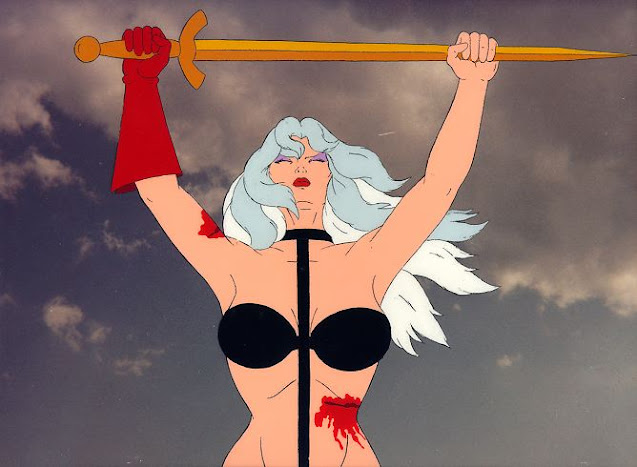Heavy Metal
1981's HEAVY METAL is a film I will always defend, always make excuses for, always find time to watch. Chalk it up to perfect timing. It's one of those movies that, no matter how old I grow, will feel like I'm seeing something I oughtn't. This animated feature, based on Heavy Metal magazine, was the forbidden catnip for many adolescent males of the day. While most of us could not get in to see the movie short of switching auditoriums in a multiplex, it was clearly aimed at our demographic. We waited with baited breath for its cable TV debut. Kids with HBO and the like were very popular, indeed. Well, kids who also either had very liberal or-absent-at-the-time-of-its-showing parents, that is.
Yes, the older I get the more sophomoric and juvenile HEAVY METAL seems. I've always, even in my widest eyed days, been able to understand why many people detest it. It's an anthology of graphically violent, vulgar, and sexist fantasies that clearly were born in the minds of horny geeks who jerked off to images of cartoon females and probably didn't know how to talk to a real woman. Well, maybe that isn't really true, but in some of the more salacious moments the film does seem that way.
For starters, every woman in this film is quite shapely, and shown naked, at least some of the time. All have breasts the size of basketballs. Until we reach reach the final episode, "Taarna", all are essentially sexual playthings for men (even for a robot in one segment!). Taarna herself is also shown in the buff a few times, but she's nobody's victim or mere bed mate. She's a heroine. In fact, spoiler alert, she sacrifices herself to save the universe from a mysterious green orb which is the essence of evil itself.
The orb, introduced early on as an astronaut unleashes it in his house (and quite unaware of its power), corners a young girl and then figures through all six stories in HEAVY METAL. It (known as Lok-Nar) also provides opening narration for each episode, explaining its pull, its dominion over a variety of humans and other life forms. Each tale features characters falling to the old vices of greed, lust, power. Some of the episodes have comedic (sometimes druggie) overtones, but the predominant air is of hopelessness, of doom. Sometimes the good guys win, but not always.
Can viewers (those not stoned) take away some sort of moral from HEAVY METAL? The messages are mixed. Every time you think you may discover something, um, decent about human nature another moment comes along to refute it. While the episode "Den" (about a scrawny kid who becomes a muscular hero) seems pretty optimistic, it's essentially a sleazy wish fulfillment saga about getting laid. "Harry Canyon" is also pretty cynical, but has an amiable hero. It is also sports the crappiest animation of the lot.
HEAVY METAL is a collection of several contrasting styles via artists from around the globe and overseen by director Gerald Potterton. The animation, much of it rotoscoped, gets better and better with each episode, culminating in the Moebious inspired "Taarna", which is worthy of comparison with the visions of H.R. Geiger.
Then there's the music. The only track that I would consider to be "heavy metal" is Black Sabbath's "The Mob Rules". The remainder features the likes of, in addition to obscure artists like Riggs and Trust, Cheap Trick, Devo, Journey, Nazareth, Don Felder, Sammy Hagar, Stevie Nicks, and even Donald Fagen! Many of these tunes rock if just a little, but some are downright mellow. Many can be considered throwaways, but all work well as placed within the movie. I listened to the heck out of that soundtrack.
HEAVY METAL played the midnight circuit for many years. I went to see it in the late '80s or early '90s at the Carefree Theater in West Palm Beach. The audience was very devoted, almost to a ROCKY HORROR PICTURE SHOW level. People were cheering and hooting all through the movie. I found it kinda funny and weird that a guy was shouting "Alright HARRRRY!" to a cartoon figure.



Comments